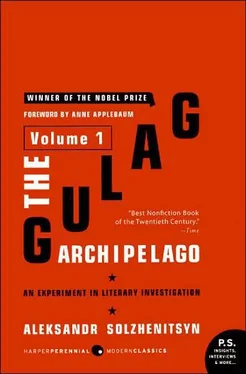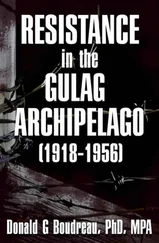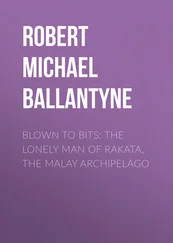Aleksandr Solzhenitsyn - The GULag Archipelago Volume 1 - An Experiment in Literary Investigation
Здесь есть возможность читать онлайн «Aleksandr Solzhenitsyn - The GULag Archipelago Volume 1 - An Experiment in Literary Investigation» весь текст электронной книги совершенно бесплатно (целиком полную версию без сокращений). В некоторых случаях можно слушать аудио, скачать через торрент в формате fb2 и присутствует краткое содержание. Город: New York, Год выпуска: 2007, ISBN: 2007, Издательство: Harper Perennial Modern Classics, Жанр: История, Биографии и Мемуары, dissident, на английском языке. Описание произведения, (предисловие) а так же отзывы посетителей доступны на портале библиотеки ЛибКат.
- Название:The GULag Archipelago Volume 1: An Experiment in Literary Investigation
- Автор:
- Издательство:Harper Perennial Modern Classics
- Жанр:
- Год:2007
- Город:New York
- ISBN:9780061253713
- Рейтинг книги:3 / 5. Голосов: 1
-
Избранное:Добавить в избранное
- Отзывы:
-
Ваша оценка:
- 60
- 1
- 2
- 3
- 4
- 5
The GULag Archipelago Volume 1: An Experiment in Literary Investigation: краткое содержание, описание и аннотация
Предлагаем к чтению аннотацию, описание, краткое содержание или предисловие (зависит от того, что написал сам автор книги «The GULag Archipelago Volume 1: An Experiment in Literary Investigation»). Если вы не нашли необходимую информацию о книге — напишите в комментариях, мы постараемся отыскать её.
“Best Nonfiction Book of the Twentieth Century” (Time magazine ) Review
The GULag Archipelago Volume 1: An Experiment in Literary Investigation — читать онлайн бесплатно полную книгу (весь текст) целиком
Ниже представлен текст книги, разбитый по страницам. Система сохранения места последней прочитанной страницы, позволяет с удобством читать онлайн бесплатно книгу «The GULag Archipelago Volume 1: An Experiment in Literary Investigation», без необходимости каждый раз заново искать на чём Вы остановились. Поставьте закладку, и сможете в любой момент перейти на страницу, на которой закончили чтение.
Интервал:
Закладка:
The years go by, and everything that has not been freshly recalled to us is wiped from our memory. In the dim distance, we see the year 1927 as a careless, well-fed year of the still untruncated NEP. But in fact it was tense; it shuddered as newspaper headlines exploded; and it was considered at the time, and portrayed to us then, as the threshold of a war for world revolution. The assassination of the Soviet ambassador in Warsaw, which filled whole columns of the papers that June, aroused Mayakovsky to dedicate four thunderous verses to the subject.
But here’s bad luck for you: Poland offered an apology; Voikov’s lone assassin was arrested there—and so how and against whom was the poet’s appeal to be directed? [21] 19. Evidently, the monarchist in question assassinated Voikov as an act of private vengeance: it is said that as Urals Provincial Commissar of Foodstuffs, in July, 1918, P. L. Voikov had directed the destruction of all traces of the shooting of the Tsar’s family (the dissection and dismemberment of the corpses, the cremation of the remains, and the dispersal of the ashes).
With cohesion,
construction,
grit,
and repression
Wring the neck
of this gang run riot!
Who was to be repressed? Whose neck should be wrung? It was then that the so-called Voikov draft began. As always happened when there were incidents of disturbance or tension, they arrested former people: Anarchists, SR’s, Mensheviks, and also the intelligentsia as such. Indeed, who else was there to arrest in the cities? Not the working class!
But the old “close-to-the-Cadets” intelligentsia had already been thoroughly shaken up, starting in 1919. Had the time not come to shake up that part of the intelligentsia which imagined itself to be progressive? To give the stucfents a once-over? Once again Mayakovsky came to the rescue:
Think
about the Komsomol
for days and for weeks!
Look over
your ranks,
watch them with care.
Are all of them
really
Komsomols?
Or are they
only
pretending to be?
A convenient world outlook gives rise to a convenient juridical term: social prophylaxis. It was introduced and accepted, and it was immediately understood by all. (Lazar Kogan, one of the bosses of the White Sea Canal construction, would, in fact, soon say: “I believe that you personally were not guilty of anything. But, as an educated person, you have to understand that social prophylaxis was being widely applied!”) And when else, in fact, should unreliable fellow travelers, all that shaky intellectual rot, be arrested, if not on the eve of the war for world revolution? When the big war actually began, it would be too late.
And so in Moscow they began a systematic search, block by block. Someone had to be arrested everywhere. The slogan was: “We are going to bang our fist on the table so hard that the world will shake with terror!” It was to the Lubyanka, to the Butyrki, that the Black Marias, the passenger cars, the enclosed trucks, the open hansom cabs kept moving, even by day. There was a jam at the gates, a jam in the courtyard. They didn’t have time to unload and register those they’d arrested. (And the same situation existed in other cities. In Rostov-on-the-Don during those days the floor was so crowded in the cellar of House 33 that the newly arrived Boiko could hardly find a place to sit down.)
A typical example from this wave: Several dozen young people got together for some kind of musical evening which had not been authorized ahead of time by the GPU. They listened to music and then drank tea. They got the money for the tea by voluntarily contributing their own kopecks. It was quite clear, of course, that this music was a cover for counterrevolutionary sentiments, and that the money was being collected not for tea but to assist the dying world bourgeoisie. And they were all arrested and given from three to ten years—Anna Skripnikova getting five, while Ivan Nikolayevich Varentsov and the other organizers of the affair who refused to confess were shot!
And in that same year, somewhere in Paris, a group of Russian émigré Lycee graduates gathered to celebrate the traditional Pushkin holiday. A report of this was published in the papers. It was clearly an intrigue on the part of mortally wounded imperialism, and as a result all Lycee graduates still left in the U.S.S.R. were arrested, as were the so-called “law students” (graduates of another such privileged special school of prerevolutionary Russia).
Only the size of SLON—the Solovetsky Special Purpose Camp—limited for the time being the scale of the Voikov draft. But the Gulag Archipelago had already begun its malignant life and would shortly metastasize throughout the whole body of the nation.
A new taste had been acquired and a new appetite began to grow. The time had long since arrived to crush the technical intelligentsia, which had come to regard itself as too irreplaceable and had not gotten used to catching instructions on the wing.
In other words, we never did trust the engineers—and from the very first years of the Revolution we saw to it that those lackeys and servants of former capitalist bosses were kept in line by healthy suspicion and surveillance by the workers. However, during the reconstruction period, we did permit them to work in our industries, while the whole force of the class assault was directed against the rest of the intelligentsia. But the more our own economic leadership matured—in VSNKh (the Supreme Council of the Economy) and Gosplan (the State Planning Commission)—the more the number of plans increased, and the more those plans overlapped and conflicted with one another, the clearer became the old engineers’ basic commitment to wrecking, their insincerity, slyness, venality. The Sentinel of the Revolution narrowed its eyes with even greater vigilance—and wherever it directed its narrowed gaze it immediately discovered a nest of wreckers.
This therapy continued full speed from 1927 on, and immediately exposed to the proletariat all the causes of our economic failures and shortages. There was wrecking in the People’s Commissariat of Railroads—that was why it was hard to get aboard a train, why there were interruptions in supplies. There was wrecking in the Moscow Electric Power System—and interruptions in power. There was wrecking in the oil industry—hence the shortage of kerosene. There was wrecking in textiles—hence nothing for a workingman to wear. In the coal industry there was colossal wrecking—hence no heat! In the metallurgy, defense, machinery, shipbuilding, chemical, mining, gold and platinum industries, in irrigation, everywhere there were these pus-filled boils of wrecking! Enemies with slide rules were on all sides. The GPU puffed and panted in its efforts to grab off and drag off the “wreckers.” In the capitals and in the provinces, GPU collegiums and proletarian courts kept hard at work, sifting through this viscous sewage, and every day the workers gasped to learn (and sometimes they didn’t learn) from the papers of new vile deeds. They learned about Palchinsky, von Meek, and Velichko, [22] 20. A. F. Velichko, a military engineer, former professor of the Military Academy of the General Staff, and a lieutenant general, had been in charge of the Administration for Military Transport in the Tsarist War Ministry. He was shot. Oh, how useful he would have been in 1941!
and how many others who were nameless. Every industry, every factory, and every handicraft artel had to find wreckers in its ranks, and no sooner had they begun to look than they found them (with the help of the GPU). If any prerevolutionary engineer was not yet exposed as a traitor, then he could certainly be suspected of being one.
And what accomplished villains these old engineers were! What diabolical ways to sabotage they found! Nikolai Karlovich von Meek, of the People’s Commissariat of Railroads, pretended to be terribly devoted to the development of the new economy, and would hold forth for hours on end about the economic problems involved in the construction of socialism, and he loved to give advice. One such pernicious piece of advice was to increase the size of freight trains and not worry about heavier than average loads. The GPU exposed von Meek, and he was shot: his objective had been to wear out rails and roadbeds, freight cars and locomotives, so as to leave the Republic without railroads in case of foreign military intervention! When, not long afterward, the new People’s Commissar of Railroads, Comrade Kaganovich, ordered that average loads should be increased, and even doubled and tripled them (and for this discovery received the Order of Lenin along with others of our leaders)—the malicious engineers who protested became known as limiters. They raised the outcry that this was too much, and would result in the breakdown of the rolling stock, and they were rightly shot for their lack of faith in the possibilities of socialist transport.
Читать дальшеИнтервал:
Закладка:
Похожие книги на «The GULag Archipelago Volume 1: An Experiment in Literary Investigation»
Представляем Вашему вниманию похожие книги на «The GULag Archipelago Volume 1: An Experiment in Literary Investigation» списком для выбора. Мы отобрали схожую по названию и смыслу литературу в надежде предоставить читателям больше вариантов отыскать новые, интересные, ещё непрочитанные произведения.
Обсуждение, отзывы о книге «The GULag Archipelago Volume 1: An Experiment in Literary Investigation» и просто собственные мнения читателей. Оставьте ваши комментарии, напишите, что Вы думаете о произведении, его смысле или главных героях. Укажите что конкретно понравилось, а что нет, и почему Вы так считаете.












